

Finance
What’s An Example Of Installment Credit?
Published: February 21, 2024
Learn about installment credit and how it works in finance. Understand the benefits and potential drawbacks of this type of credit. Discover examples and tips for managing installment credit effectively.
(Many of the links in this article redirect to a specific reviewed product. Your purchase of these products through affiliate links helps to generate commission for LiveWell, at no extra cost. Learn more)
Table of Contents
Introduction
Understanding the Basics of Installment Credit
Installment credit is a fundamental component of the modern financial landscape, playing a pivotal role in enabling individuals to make significant purchases and investments. This type of credit offers consumers the flexibility to acquire high-value items, such as homes, vehicles, and major appliances, without having to pay the entire amount upfront. Instead, the purchase price is divided into fixed, manageable payments over a specified period, making it more accessible to a wider range of consumers.
Installment credit is a testament to the symbiotic relationship between financial institutions and consumers. It allows individuals to fulfill their needs and desires while providing a steady stream of revenue for lenders through the accrual of interest. This mutually beneficial arrangement has become an integral part of the global economy, driving consumption and economic growth.
Understanding the nuances of installment credit is essential for anyone seeking to make informed financial decisions. By delving into its intricacies, individuals can gain valuable insights into managing their credit responsibly, leveraging it to achieve their goals, and navigating the diverse array of credit options available to them. In the following sections, we will explore the various types of installment credit, delve into real-world examples, and elucidate the significance of this financial instrument in shaping consumers' purchasing power and financial well-being.
Understanding Installment Credit
Installment credit is a form of borrowing that enables individuals to make a purchase and repay the amount over time through a series of scheduled payments. Unlike revolving credit, such as credit cards, where the balance can fluctuate and the repayment terms vary, installment credit involves borrowing a fixed amount and adhering to a predetermined repayment schedule.
One of the defining characteristics of installment credit is the structured nature of the repayment plan. Each payment consists of both principal and interest, with the former contributing to reducing the outstanding balance while the latter represents the cost of borrowing. This predictable payment structure provides borrowers with clarity and enables them to budget effectively, knowing exactly how much is due at each installment.
Furthermore, installment credit often comes with a fixed interest rate, meaning that the cost of borrowing remains constant throughout the repayment period. This stability offers borrowers a sense of security, as they can anticipate the total interest expense over the life of the loan, facilitating prudent financial planning.
Another aspect that distinguishes installment credit is the purpose for which it is typically utilized. This type of credit is commonly associated with major purchases that require a substantial amount of funds, such as real estate, automobiles, and higher education. By spreading the cost of these significant expenses over time, installment credit makes these investments more attainable for individuals who may not have the immediate means to pay the full amount upfront.
Understanding the mechanics of installment credit empowers consumers to make informed decisions when evaluating borrowing options. By comprehending the structure, repayment terms, and implications of installment credit, individuals can navigate the borrowing landscape with confidence, selecting the most suitable financial instruments to meet their specific needs and aspirations.
Types of Installment Credit
Installment credit encompasses a diverse array of financial products tailored to accommodate various borrowing needs and preferences. Understanding the different types of installment credit is instrumental in selecting the most suitable option for specific financial endeavors. Here are some prevalent forms of installment credit:
- Mortgages: A mortgage is a quintessential example of installment credit, enabling individuals to purchase homes by borrowing a substantial sum of money and repaying it over an extended period, typically spanning several decades. Mortgages often feature fixed or adjustable interest rates and may require a down payment to secure the loan.
- Auto Loans: Auto loans allow individuals to acquire vehicles by borrowing the necessary funds and reimbursing the amount over a predetermined term. These loans can be obtained from banks, credit unions, or auto financing companies, and the vehicle serves as collateral to secure the loan.
- Personal Loans: Personal loans offer borrowers a versatile form of installment credit, as the funds can be utilized for various purposes, such as consolidating debt, funding home improvements, or covering unexpected expenses. These loans are typically unsecured, meaning they do not require collateral, and the interest rates may vary based on the borrower’s creditworthiness.
- Student Loans: Designed to facilitate access to higher education, student loans provide individuals with the means to cover tuition, books, and living expenses while pursuing academic endeavors. These loans often feature favorable terms, including deferred payments and income-driven repayment plans.
- Appliance and Furniture Financing: Retailers and financial institutions offer installment credit for the purchase of appliances, furniture, and electronics, allowing consumers to acquire these items and pay for them over time. Promotional financing options, such as zero-interest periods, are commonly available for qualifying purchases.
Each type of installment credit caters to distinct financial objectives and presents unique terms and conditions. By familiarizing themselves with these variations, individuals can make well-informed decisions when seeking to utilize installment credit for specific acquisitions or financial needs.
Examples of Installment Credit
Examining real-world instances of installment credit provides valuable insights into how this financial tool facilitates major purchases and investments. The following examples illustrate the diverse applications of installment credit in meeting consumers’ varied needs:
- Mortgage for Home Purchase: A family wishes to purchase a new home and secures a mortgage from a financial institution. The mortgage enables them to acquire the property by making a down payment and committing to monthly installments over a 30-year term. This form of installment credit empowers individuals and families to achieve homeownership without bearing the entire cost upfront, thereby spreading the financial commitment over a manageable timeframe.
- Auto Loan for Vehicle Purchase: An individual aspires to buy a car and opts for an auto loan to finance the purchase. By obtaining an installment credit arrangement, the buyer can drive the vehicle home after making a down payment and commit to repaying the borrowed amount, along with interest, in monthly installments over a specified period. Auto loans exemplify how installment credit facilitates the acquisition of high-value assets while aligning the repayment with the utility derived from the purchase.
- Personal Loan for Debt Consolidation: A consumer seeks to streamline their finances and alleviate the burden of multiple high-interest debts. They apply for a personal loan, which, upon approval, allows them to consolidate their outstanding obligations into a single, structured repayment plan. The installment credit in the form of a personal loan not only simplifies the repayment process but also potentially reduces the overall interest expense, providing a pathway to financial stability.
- Student Loan for Higher Education: A student pursues a college education and relies on student loans to cover tuition, books, and living expenses. By leveraging installment credit in the form of student loans, the individual can invest in their academic and professional development, with the flexibility of commencing repayment after completing their studies. This exemplifies how installment credit fosters access to education and skill development, shaping individuals’ future prospects.
- Furniture Financing for Home Furnishings: A homeowner wishes to furnish their residence with quality furniture and appliances, opting to utilize installment credit offered by a retailer. Through this financing arrangement, the individual can acquire the desired items and spread the cost over manageable installments, often benefitting from promotional terms that enhance affordability. This showcases how installment credit extends purchasing power and enhances consumers’ living standards.
These examples underscore the versatility and impact of installment credit in enabling individuals to realize their aspirations, whether it involves homeownership, transportation, financial consolidation, education, or enhancing their living environment. By embracing installment credit, consumers can navigate significant life events and acquisitions with greater financial flexibility and confidence.
Conclusion
Installment credit stands as a cornerstone of the modern financial landscape, empowering individuals to fulfill their aspirations, acquire essential assets, and navigate life’s pivotal milestones with financial flexibility. By comprehending the mechanics and implications of installment credit, consumers can make informed decisions when leveraging this financial tool to support their endeavors.
The diverse array of installment credit options, including mortgages, auto loans, personal loans, student loans, and retail financing, underscores the adaptability of this credit mechanism in catering to a myriad of needs. Whether it involves purchasing a home, acquiring a vehicle, consolidating debts, pursuing education, or enhancing one’s living environment, installment credit offers a structured and manageable pathway to realizing these objectives.
Furthermore, the structured nature of installment credit, characterized by fixed repayment schedules and predictable interest costs, fosters financial discipline and prudent budgeting. This stability enables borrowers to plan effectively, manage their obligations responsibly, and achieve a harmonious balance between their financial aspirations and their long-term well-being.
As consumers navigate the complexities of the borrowing landscape, a nuanced understanding of installment credit equips them to make strategic financial choices aligned with their goals and circumstances. By embracing installment credit judiciously and leveraging it as a catalyst for progress, individuals can embark on transformative journeys, secure essential assets, and pursue personal and professional growth with confidence.
In essence, installment credit transcends mere financial transactions; it embodies the realization of dreams, the pursuit of knowledge, the creation of homes, and the enhancement of livelihoods. Its impact reverberates across generations, shaping prosperity, fostering stability, and nurturing the human spirit’s innate drive to progress and thrive.
By embracing the possibilities offered by installment credit and approaching it with mindfulness and foresight, individuals can harness its potential to propel themselves toward a future imbued with financial empowerment, resilience, and boundless opportunities.














